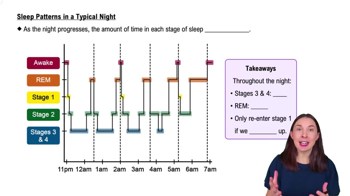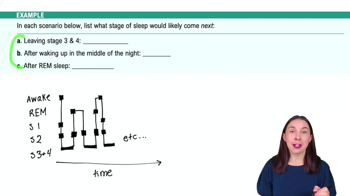Table of contents
- 1. Introduction to Psychology1h 43m
- 2. Psychology Research2h 20m
- 3. Biological Psychology2h 41m
- 4. Sensation and Perception28m
- 5. Consciousness and Sleep32m
- 6. Learning41m
- 7. Memory34m
- 8. Cognition37m
- 9. Emotion and Motivation35m
- 10. Developmental Psychology33m
- 11. Personality48m
- 12. Social Psychology41m
- 13. Stress and Health41m
- 14. Psychological Disorders44m
- 15. Treatment47m
5. Consciousness and Sleep
Sleep
Struggling with Psychology?
Join thousands of students who trust us to help them ace their exams!Watch the first videoMultiple Choice
Ecstasy is classified as a
A
major tranquilizer.
B
narcotic.
C
stimulatory hallucinogenic.
D
benzodiazepine.
 Verified step by step guidance
Verified step by step guidance1
Understand the classification of drugs: Drugs are often categorized based on their effects on the central nervous system. Common categories include stimulants, depressants, hallucinogens, and narcotics.
Identify the effects of Ecstasy: Ecstasy, also known as MDMA, is known for its stimulant and hallucinogenic properties. It increases energy, emotional warmth, and distorted sensory and time perception.
Differentiate between drug categories: Major tranquilizers (antipsychotics) are used to treat severe mental disorders and are not typically associated with the effects of Ecstasy. Narcotics are primarily pain-relieving drugs, and benzodiazepines are used for anxiety and sleep disorders.
Recognize the unique category of Ecstasy: Ecstasy is often classified as a 'stimulatory hallucinogenic' due to its ability to both stimulate the central nervous system and produce hallucinogenic effects.
Conclude with the correct classification: Based on its effects, Ecstasy is best classified as a stimulatory hallucinogenic, which combines elements of both stimulants and hallucinogens.

 3:25m
3:25mWatch next
Master Circadian Rhythms with a bite sized video explanation from Hannah Gordils
Start learningRelated Videos
Related Practice


































































































![Race, Genes and IQ Differences | Bret Weinstein [Mini Clip]](https://img.youtube.com/vi/IztL_m3pd70/mqdefault.jpg)



































































































